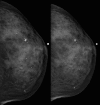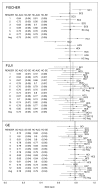Comparison of soft-copy and hard-copy reading for full-field digital mammography
- PMID: 19332845
- PMCID: PMC2663585
- DOI: 10.1148/radiol.2511071462
Comparison of soft-copy and hard-copy reading for full-field digital mammography
Abstract
Purpose: To compare radiologists' performance in detecting breast cancer when reading full-field digital mammographic (FFDM) images either displayed on monitors or printed on film.
Materials and methods: This study received investigational review board approval and was HIPAA compliant, with waiver of informed consent. A reader study was conducted in which 26 radiologists read screening FFDM images displayed on high-resolution monitors (soft-copy digital) and printed on film (hard-copy digital). Three hundred thirty-three cases were selected from the Digital Mammography Image Screening Trial screening study (n = 49,528). Of these, 117 were from patients who received a diagnosis of breast cancer within 15 months of undergoing screening mammography. The digital mammograms were displayed on mammographic workstations and printed on film according to the manufacturer's specifications. Readers read both hard-copy and soft-copy images 6 weeks apart. Each radiologist read a subset of the total images. Twenty-two readers were assigned to evaluate images from one of three FFDM systems, and four readers were assigned to evaluate images from two mammographic systems. Each radiologist assigned a malignancy score on the basis of overall impression by using a seven-point scale, where 1 = definitely not malignant and 7 = definitely malignant.
Results: There were no significant differences in the areas under the receiver operating characteristic curves (AUCs) for the primary comparison. The AUCs for soft-copy and hard-copy were 0.75 and 0.76, respectively (95% confidence interval: -0.04, 0.01; P = .36). Secondary analyses showed no significant differences in AUCs on the basis of manufacturer type, lesion type, or breast density.
Conclusion: Soft-copy reading does not provide an advantage in the interpretation of digital mammograms. However, the display formats were not optimized and display software remains an evolving process, particularly for soft-copy reading.
Figures




References
-
- Pisano ED, Gatsonis C, Hendrick E, et al. Diagnostic performance of digital versus film mammography for breast-cancer screening. N Engl J Med 2005;353:1773–1783. - PubMed
-
- Nishikawa RM, Mawdsley GE, Fenster A, Yaffe MJ. Scanned-projection digital mammography. Med Phys 1987;14:717–727. - PubMed
-
- Bick U, Giger ML, Schmidt RA, Nishikawa RM, Doi K. Density correction of peripheral breast tissue on digital mammograms. RadioGraphics 1996;16:1403–1411. - PubMed
-
- Byng JW, Critten JP, Yaffe MJ. Thickness-equalization processing for mammographic images. Radiology 1997;203:564–568. - PubMed
-
- Berns EA, Hendrick RE, Solari M, et al. Digital and screen-film mammography: comparison of image acquisition and interpretation times. AJR Am J Roentgenol 2006;187:38–41. - PubMed
Publication types
MeSH terms
Grants and funding
LinkOut - more resources
Full Text Sources
Medical

